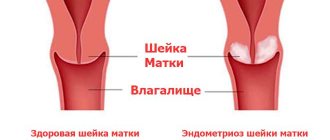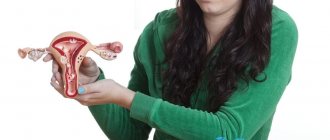general description
Duplication of the uterine body with duplication of the cervix and vagina (Q51.1) is a congenital defect in the development of the uterus due to incomplete fusion of the paired Müllerian canals during intrauterine development, in which two isolated uteruses are identified, from each there is a fallopian tube with an ovary, two separate cervixes and two vaginas.
Both uterus and vagina may be separated by the bladder and rectum or may be in close contact with the walls. In some cases, both uteruses are anatomically and functionally complete, in others, one of the halves is less developed. Often this defect is combined with other defects of the genitourinary system. Prevalence of uterine anomalies: 2 per 10 thousand women.
Risk factors for the development of the defect: occupational hazards, bad habits, viral infections (influenza, rubella, toxoplasmosis), toxic effects of medications that affect the body of a pregnant woman, especially in the first weeks of pregnancy. There is a genetic predisposition.
Anatomical variants of doubling
The uterus with appendages is formed in the first trimester of gestation by the fusion of two perinephric (Müllerian) ducts, after which further development and transformation of the organ occurs. Unfavorable factors exerted during this period cause a deviation from the normal formation of the reproductive system. An additional trigger is heredity.
The offspring of women who have been diagnosed with uterine pathology have an increased risk of developing developmental anomalies of various localizations.
There are several types of anlage disorders, depending on the time of formation of the defect and the degree of fusion of the Müllerian ducts:
- Complete doubling: a woman has two uteruses, two cervixes and two vaginas. The ducts do not connect, completely independent organs are formed. Each uterus has its own fallopian tube and ovary. Organs can touch each other or they can be separated by the intestines and bladder. Functioning is usually not impaired; pregnancy can occur alternately in each part.
- The deviation is more common when there are also 2 uteruses, 2 cervixes and 2 vaginas. However, the organs are connected by a fibrous membrane. The membrane is mainly found in the area of the isthmus or neck. This option is often accompanied by the formation of additional anomalies: underdevelopment of one uterus, atresia of the vagina and hymen. With this structure, there are cases when the second vagina is underdeveloped and closes blindly.
- Bicornuate uterus, incomplete duplication is a pathological condition when there is a common vagina, and the cervix and uterus are bifurcated. In this case, the organs are connected by a thin septum, which may not extend the entire length.
Causes of the anomaly
Pathology of the structure of the reproductive apparatus develops in the early prenatal period. The reason is the lack of normal fusion of the Müllerian ducts. The trigger mechanism can be different:
- use of toxic, teratogenic drugs;
- bad habits;
- hereditary factors;
- severe toxicosis;
- hormonal imbalance;
- Fetal nutritional disorder: placental insufficiency, abnormal placental attachment;
- past infections and inflammatory processes during pregnancy.
Symptoms of duplication of the uterine body with duplication of the cervix and vagina
The presence of two separate uteruses and vaginas may not cause clinical manifestations.
With complete duplication of the uterus and vagina in combination with aplasia or atresia of one vaginal cavity, 3–6 months after the first menstruation, a picture of hematocolpos, hematometra, hematosalpinx develops on the side of the separate cavity. Clinical manifestations in this case are severe bursting pain in the lower abdomen, not relieved by antispasmodics and analgesics.
If the double uterus is full, pregnancy is possible, but usually occurs with the threat of spontaneous abortion and premature birth. Childbirth with doubling of the uterine body is often complicated by incoordination or weakness of labor, heavy postpartum bleeding, and lochiometer.
A gynecological examination reveals duplication of the cervix and vagina. During a rectoabdominal examination, hematocolpos, hematometra, is determined in the form of a tumor-like immobile formation of tight-elastic consistency (in the case of aplasia or atresia of one vaginal cavity).
Two uteruses and two cervixes – Gynecology
Complete duplication of the uterus is a rare anomaly in the development of the female reproductive system, characterized by the formation of two uteruses with separate cervixes. In some cases, the formation of two vaginas is possible, but this pathology is extremely rare.
Pregnancy at doubling
The presence of two uteruses in a woman may not be detected until the onset of labor. In the history of medicine, there are cases of simultaneous development of a child in two uteruses, but most often the fetus is in one of them.
Possible complications of pregnancy during doubling:
- abnormal position of the fetus;
- incoordination or weakness of labor;
- postpartum bleeding (especially if the vaginal septum is ruptured);
- premature birth;
- miscarriage.
However, the development of two uteruses in a woman is more often determined during a gynecological examination or infertility treatment. The inability to conceive and bear a baby is a common occurrence when an organ is duplicated. It is typical for 50-60% of cases of atypical development.
A woman’s two uteruses can be absolutely complete; in a number of other cases, one of them turns out to be underdeveloped. With complete doubling of an organ, pregnancy may occur in any of them.
If there is one developed and the second rudimentary pregnancy occurs in a full-fledged uterus. The development of the fetus in rudimentary form is considered an ectopic pregnancy and becomes a threat to the woman’s health.
A defective organ may rupture and the fetus may enter the abdominal cavity.
Factors in the development of the anomaly
A woman's two uteruses are formed during intrauterine development. The reason is the lack of fusion of the two initially developing uterine cavities. Failure of proper formation is caused by the unfavorable factors presented below.
- Lack of a healthy lifestyle culture among parents (especially the mother). First of all, this concerns habits and living conditions that lead to chronic intoxication of the body. Addiction to alcohol, nicotine or energy drinks also leads to constant intoxication, leading to negative consequences.
- Infections of the reproductive system suffered during pregnancy or immediately before conception. It is extremely important to follow the recommendations of specialists when planning a pregnancy, since after treatment of some infections a long recovery period is required. At this time, conception is not recommended.
- Situations that promote the release of stress hormones (cortisol, adrenaline, prolactin). They have an extremely negative effect on internal processes in the body. The best method to combat this factor is a good mood and an optimistic outlook on life. During pregnancy, it is especially important to monitor your emotional background.
- Hormonal imbalances. Hormones regulate the normal functioning of all human organs and systems, including the processes of formation of the unborn baby. Disruption of the endocrine system provokes developmental pathologies, including uterine duplication. The following pathologies can cause hormonal imbalance: diabetes mellitus, diseases of the thyroid gland, ovaries and adrenal glands.
- Malnutrition. Depletion of the diet in vitamins or minerals leads to various changes in the body, including the development of a number of anomalies.
The listed factors are not specific. In addition to the development of two uteruses with two cervixes and (rarely) two vaginas, they can cause any pathology of fetal formation or provoke diseases in the woman.
Important! A healthy lifestyle and the elimination of harmful factors that affect health are the best basis for the development and birth of a healthy baby.
Symptoms of doubling
A woman with two uteruses may never feel pathology in herself. Situations where such a structure does not cause negative feelings and does not interfere with the birth of a healthy child are considered the norm. Menstruation occurs simultaneously in both uteruses. However, various manifestations are possible:
- 3 months after the onset of the first menstruation, a pronounced feeling of fullness in the lower abdomen occurs.
- Brown or bloody spotting may appear in the middle of the cycle. The symptom occurs when there is a fistulous tract between two uteruses. This opening is located in the septum that separates the two vaginas.
- Penetration of infection into the uterine cavity through a fistulous tract can be manifested by the discharge of blood with pus, which becomes permanent.
- The manifestation of the presence of a double uterus during childbirth is characterized by a decrease or discoordination of labor. Heavy postpartum bleeding is also possible.
- Infertility.
- Inability to carry a child to term, premature birth or miscarriage.
- Cycle disturbances, heavy or scanty menstrual flow.
- Periodically occurring cramping pain in the lower abdomen.
The listed symptoms do not always indicate directly a bifurcation of the organ, but only indicate a deviation in the health of the reproductive system. Given the rarity of the pathology (about one case in four million women), doctors identify this feature only after conducting a thorough examination.
The development of 2 uteruses with 2 cervixes may not always have manifestations. About 50% of women do not feel the peculiarity of the structure and learn about the anomaly during an ultrasound examination of the pelvic organs. However, even ultrasound does not always determine pathology. In the absence of symptoms, doubling is considered normal and does not require treatment.
Diagnostics
The diagnosis of doubling of the main reproductive organ is made on the basis of a complete gynecological examination, which consists of the following:
- collection of complaints and inspection;
- Ultrasound of the pelvis;
- MRI of the pelvic organs;
- hysteroscopy;
- colposcopy;
- Ultrasound examination of the kidneys.
An experienced gynecologist can identify or suspect a developmental anomaly (if there are two cervixes) during a routine gynecological examination.
Treatment
If the reproductive system is functioning normally, no treatment is required. During pregnancy, control over the condition of the uterus and fetal development increases.
However, if the menstrual cycle is disrupted, pain occurs, or infertility develops, surgical intervention is necessary. The type of operation is selected taking into account the structure of the organs, the development of both halves of the uterus and the general health of the woman.
If the outflow of menstrual fluid is disrupted, severe pain syndrome (algomenorrhea) is observed. This complication occurs in adolescence after the onset of menstruation and requires surgery.
The surgeon excises the septum between the uteri, forms a single cavity and sanitizes the vagina. This type of intervention is called metroplasty (formation of one uterine cavity from two existing ones).
In the absence of serious disorders, when only a disruption of the menstrual cycle is observed, hormonal therapy is used. No surgery required.
Important! Duplication of the uterus affects the functioning of the pelvic organs. Treatment of organ duplication must be carried out under the supervision of a nephrologist and urologist.
Source:
Two uteruses in women and pregnancy, diagnosis, treatment, risks
In obstetric practice, there are sometimes unique cases of a woman having two uteruses. This natural anomaly causes concern among owners. Having received such a diagnosis, a woman begins to worry about how to get pregnant if there are 2 uteruses.
This feature of the development of the organ does not contradict its main function - childbirth. Obstetricians know a sufficient number of cases of successful motherhood with a similar pathology.
What to do if a double uterus is diagnosed? How is pregnancy progressing? What features should you pay attention to? Detailed information is below in the article.
Features of the female body with a bifurcated uterus
The pathology begins during the period of embryonic development. There are many reasons for the incorrect placement of an organ.
In the first stages, under the influence of negative environmental factors, the embryonic uterus forms very slowly. This leads to the fact that the woman ends up with two uterine cavities. This type of pathology is the most common.
If the developmental deviation was too strong, then the uterine cervix, and even the vagina, can double in size. Most women with this pathology are not even aware of its presence.
Developmental anomalies are diagnosed during pregnancy using ultrasound examination.
The abnormal structure of the organ does not affect the menstrual cycle and egg maturation. However, pregnancy often comes with complications. Therefore, women with two uteruses require closer medical supervision.
Often such a pregnancy requires hospital stay throughout the entire period of the child's development.
Ways to treat pathology
In most cases, 2 uteri do not require special treatment. For women, this pathology does not cause discomfort. In complex forms of organ abnormality, surgical intervention may be required.
Indications for surgical treatment of a double uterus:
- acute inflammatory processes that occur in the organ cavity;
- inability to pass menstrual flow.
In such cases, the woman has the pathological organ or its paired part removed. All other cases of disease do not require such a radical solution.
Also, removal of the second uterus is used if a woman has problems conceiving. In this case, one organ is surgically formed from two uteruses. As a rule, this method solves the problem of conception.
If during the examination it is determined that one of the uteruses cannot contain a fetus, it must be removed.
Classification and reasons
The classification of this pathology is based on the doubling of certain parts of the female reproductive system. Highlight:
- complete duplication of the uterus and vagina;
- doubling of the uterine body only (bicornuate uterus);
- doubling of the body and neck.
Pathology of the structure of the uterus is often accompanied by defects in the development and functioning of the urinary system.
Reasons why women develop two uteruses:
- maternal use of steroid drugs;
- use of antibacterial dosage forms;
- excessive consumption of alcoholic beverages;
- nicotine entering the fetus’s body due to maternal smoking;
- severe forms of toxicosis and gestosis;
- hereditary and genetic predisposition;
- incorrect hormonal composition in a woman who is carrying a child;
- improper attachment of the placenta;
- viral and infectious processes in the mother’s body;
- inflammation of the female reproductive system.
The most common cause of uterine pathology is the incorrect lifestyle of the expectant mother. Alcohol, smoking, and drugs disrupt the process of formation and formation of internal organs.
As a result, a pathology in the form of two uteruses may occur.
Characteristic symptoms and diagnosis
Two uteruses in women have the following symptoms:
- pain in the lower abdomen;
- irregular menstrual cycle;
- bloody discharge from the vaginal cavity;
- purulent vaginal discharge;
- absence of menstruation;
- problems with conception and infertility;
- spontaneous miscarriage after conception has taken place;
- severe bleeding during childbirth;
- insufficient labor activity or its complete absence.
Unpleasant symptoms occur with concomitant diseases and pathologies. The presence of two uteruses, as a rule, is asymptomatic for a woman and does not cause discomfort.
Very often, this pathology is diagnosed by ultrasound during a routine examination or during pregnancy registration. This is due to the fact that the pathology, in most cases, occurs without negative manifestations.
Diagnostics
- Ultrasound of the pelvic organs.
| Duplication of the uterus and vagina, partial aplasia of one vagina until hematocolpos is emptied. 1, 2 - two uteruses; 3 - closed vagina |
- MRI of the pelvic organs.
| T2-weighted axial (a) image shows duplication of the uterus (thin solid arrows) and cervixes (thin dotted arrows). The vagina is doubled, there is aplasia of the lower third of the left vagina and mucocolpos on the left (b) (thick solid arrow) | Double uterus - three axial sections at the level of the body of the uterus, cervix, vagina (a, c, e) and one coronal section (b) |
- Colposcopy.
- Hysteroscopy.
- Ultrasound of the kidneys.
- Laparoscopy.
Differential diagnosis: other anomalies of uterine development.
Symptoms, causes, treatment of double uterus. Is pregnancy possible?
Duplication of the uterus is a congenital pathology of the structure of the female genital organs, which is characterized by the presence of two uteruses and two bifurcated vaginas. If this anomaly does not cause disruption to the functioning of other organs or does not affect the regularity of menstruation, treatment is not required. In other cases, the problem is solved surgically.
Reasons for doubling
Absolutely all pathologies of the structure of the uterus are associated with disruption of the development of the embryo and changes in the environment in which it is formed. It could also be poor gas exchange.
The main factors that influence the abnormal development of the embryo are:
- Constant stress, nervousness, hysteria;
- Diseases and disorders of the endocrine system:
- Diabetes;
- Ovarian dysfunction;
- Enlarged thyroid gland;
- Infections and diseases in the early stages of pregnancy, during the formation of the uterus in the embryo;
- Taking medications that can harm the development of the fetus;
- Poor nutrition, lack of vitamins and minerals in the body of a pregnant woman;
- Severe toxicosis in the first trimester and toxicosis at the end of pregnancy;
- Alcohol and drug use by pregnant women. Smoking, radiation;
- Heredity;
- Kidney doubling. Experts note a certain connection between the formation of the kidneys and genitals. There are often cases when a fetus with a double kidney begins to develop two uteruses.
Possible complications
Two uteruses in a woman often cause deterioration in the functioning of other genital organs and health, both physical and psychological.
In most cases, there is a difficulty in the outflow of menstrual fluid, which leads to its accumulation in a closed space. In this regard, most women begin to experience algodismenorrhea - a bursting pain syndrome that occurs in the lower abdomen.
The pain is so severe that no painkillers or antispasmodics help. Pain sensations increase.
In some women, a fistula forms in the vaginal lining. In this case, menstrual blood is still excreted in small quantities. Soon a secondary infection of the genital organs appears and purulent discharge begins.
When the functioning horn is closed, a bicornuate organ may appear. This complication of doubling occurs in adolescents. With the arrival of the first menstruation, pain in the form of contractions of varying intensity is noted in the lower abdomen.
Incidence (per 100,000 people)
| Men | Women | |||||||||||||
| Age, years | 0-1 | 1-3 | 3-14 | 14-25 | 25-40 | 40-60 | 60 + | 0-1 | 1-3 | 3-14 | 14-25 | 25-40 | 40-60 | 60 + |
| Number of sick people | 0 | 0 | 0 | 0 | 0 | 0 | 0 | 0 | 0 | 0.2 | 0.6 | 0.6 | 0.6 | 0 |
Causes
The following factors can provoke the occurrence of pathology during embryonic development:
- consumption of alcoholic beverages by the mother, as well as smoking, drug addiction,
- bad heredity,
- inflammatory, viral, infectious processes in the pelvic organs of a woman,
- hormonal disorders,
- improper fixation of the placenta,
- taking certain types of medications by a pregnant woman,
- severe form of toxicosis, etc.
Causes of genetic defects
The prevalence of the anomaly is low - only 2% of cases. Pathology develops exclusively during intrauterine development and cannot arise subsequently. A woman should seriously think about the health of her unborn baby, eliminating possible risks long before pregnancy. Among the risk factors, modern doctors note:
- Harmful working conditions . Chemical production is not the best place for an expectant mother to work. Even at the stage of pregnancy planning, doctors recommend changing your field of activity to a safe one.
- Unfavorable environmental living conditions . It is difficult to find an oasis of pure nature in the modern world, but this does not mean that you need to live in the city all the time. Doctors advise taking an annual vacation to the sea, forest or mountains to restore and maintain your own health.
- Bad habits . Excessive drinking and smoking do not add beauty to a woman - on the contrary, they take away her youth. Before getting pregnant, it is advisable to give up bad habits. In the first months of bearing a baby, even a sip of alcohol on a holiday can have a negative impact on the development of the fetus.
- Infections of viral etiology . The most dangerous include toxoplasmosis, rubella and influenza. As a preventive measure, it is necessary to avoid crowded places during an outbreak of influenza epidemic. Rubella is extremely rare due to mass vaccination of the population, and an ordinary cat can become a carrier of toxoplasma. If a girl came into contact with this pet as a child, she developed an immune defense. But if a pregnant woman decides to get a cat for the first time, this idea will have to be abandoned. Duplication of the uterus and vagina in the unborn child is only a small part of the troubles that toscoplasmosis brings.
- Medications . The effect of taking medications should not exceed the risks to the fetus, so self-medication is dangerous. At the first symptoms of any disease, you should consult a doctor, indicating the duration of pregnancy at the appointment.
- Genetic predisposition . If one of your close female relatives is diagnosed with a similar defect, the risk of developing an anomaly increases.
Treatment
If the presence of two uteruses does not cause any discomfort to the patient and no pathological conditions are observed against the background of the anomaly, then in this situation no therapy is carried out. In severe cases, doctors decide to perform surgical treatment:
- the process of removing menstrual fluid is disrupted,
- acute inflammatory processes,
- pregnancy in the horn.
If surgery is performed, the patient will have a paired part of the pathological organ removed. Once a woman has one uterus left, there will be fewer risks for her in the process of conception. But she will definitely need consultation and constant monitoring of a gynecologist.
Establishing the diagnosis of “2 vaginas and 2 uteruses”
Step-by-step diagnosis of the anomaly is accompanied by:
- familiarization with the anamnesis;
- gynecological examination, including recto-abdominal (bimanual);
- vaginoscopy - examination by a doctor of double vaginas and uteruses;
- colposcopy - examination of the entrances to both vaginas, the walls of the vaginas and the vaginal part of the cervixes of 2 uteruses using a special device;
- hysteroscopy - visual examination of the uterine cavities and assessment of the condition of their internal surface using an optical system;
- Ultrasound or MRI of the pelvis;
- Ultrasound and CT scan of the kidneys;
- laparoscopy.
Continuous duplication of the vagina and cervix is visually determined even at the stage of visiting a gynecologist and performing vaginoscopy.
- If there is an absence of one vagina, it is possible to examine only a full vagina - it is in its dome that one cervix is found. When performing vaginoscopy in a double uterus and the absence of an additional vagina, a bulge is detected in the area of the lateral wall of the vagina. And with a recto-abdominal examination, hematocolpos and hematometra are revealed - they look like a tumor-like static formation of a tight-plastic texture.
- A recto-abdominal examination with an existing fistulous tract is accompanied by increased purulent discharge. With a rudimentary closed horn, 1 vagina and 1 cervix are detected, but a recto-abdominal examination makes it possible by palpation to detect a pathological creation near the uterus, tending to increase in menstrual cycles. Again, a hematosalpinx is recognized on the side of the rudimentary closed horn.
- Pelvic ultrasound determines the size of the cavities of the 2 uteruses with their characteristic twinning, the volume of hematocolpos and hematometers. Ultrasound of the kidneys is considered indispensable when diagnosing. If there are atypical manifestations of two uteruses and vaginas, it is more rational to perform an MRI of the pelvis, hysteroscopy and laparoscopy.
Two vaginas (5 associated symptoms)
The formation of pathology occurs against the background of the influence of harmful factors on the intrauterine fetus, when the expectant mother is still carrying it.
This may be a negative impact of professional activity or detrimental weaknesses of a pregnant woman, after a viral infection (and this is influenza, rubella, toxoplasmosis), or taking toxic medications.
All these harmful factors have a particularly bad effect on the development of the fetus during the period 8–16 weeks of gestation.
The owner of double vaginas and uteruses, depending on the anatomical form of the defect, often experiences:
- algodismenorrhea (disorder in the menstrual cycle);
- hematocolpos (hemorrhage);
- hematometra (accumulation of menstrual blood in the uterus);
- infertility;
- termination of pregnancy (miscarriage).
But often the emerging defect does not manifest itself in any way, being asymptomatic. 2 vaginas are diagnosed through examination by a gynecologist, ultrasound, MRI, hysteroscopy and laparoscopy.
The doctor decides which method of eliminating the anomaly by surgery is chosen based on the characteristics of the anatomical and functional damage.
Treatment methods for 2 vaginas and uteruses
Surgical tactics are resorted to in the presence of a complete duplication of the uterus and a fragmentary absence of 1 vagina and distorted flow of menstrual blood.
The vaginal stage of the operation involves cutting the vaginal walls and creating a connection between the cavities with preserved function and closure.
At the same time, the hematocolpos is opened and drained, and the vagina is sanitized. The laparoscopic stage includes clarification of the relative position of the uterus, cleansing of the hematometra and hematosalpinx, and sanitization of the abdominal sinus.
When the hymen is closed, an X-like opening of the hymen is performed using local anesthesia and the hematocolpos is removed.
If, upon examination by a gynecologist, an additional closed horn is detected, this is considered a reason for hysterectomy - removal of the rudimentary uterus while sparing the ovary and fallopian tube.
The separator inside the uterus is a signal to perform metroplasty, but only if childbearing is impaired.
When there is a double uterus with a complete or fragmented absence of 2 vaginas, colpoelongation is used - dilatation (expansion) of the vagina and abdominal colpopoiesis - plastic surgery to form an artificial vagina from the peritoneum.
Different approaches to solving the problem of having a duplicate vagina and uterus help improve the quality of the patient’s sexual life.
We recommend watching an interesting video on an intimate topic:
Reviews
On forums, statements from patients with pathologies such as 2 vaginas and 2 uteruses regarding bearing a child and its birth are more common.
EVGENIYA, 27 YEARS OLD, KEMEROVO:
“I have a full set of double reproductive apparatus.
It contains only 2 - uterus, cervix, vagina with an axial septum. And now I'm expecting a baby. The first one was given birth through cesarean section, the doctors explained that the child would not have progressed through the birth canal. It is possible to become pregnant with such a septum, but it is more difficult to carry a baby - the uterus is somewhat smaller and more elastic than a normal one.
If the septum is horizontal, then it becomes an obstacle to the uterus. So just delete it."
YULIA, 30 YEARS OLD, IVANOVO:
“My anomaly is 2 uteruses, 2 cervical canals, a continuous cervical septum. Nevertheless, she became pregnant twice and carried her children. We got a son from the first cycle, a daughter from the second. In both cases there was surgery."
Possible complications
Many women with this pathology experience the following complications:
- deterioration of health,
- dysfunction of other organs of the genitourinary system,
- psychological disorders,
- difficult outflow of menstrual flow,
- painful sensations in the lower part of the peritoneum,
- the occurrence of a fistula in the vagina,
- infection,
- purulent discharge, etc.










